#DataTypes in C
Explore tagged Tumblr posts
Text
youtube
C DataTypes | DataTypes in C | Example of C DataTypes
In C programming, data types specify the type of data that can be stored in a variable. They define the operations that can be performed on the data and the memory required to store it. Below are the primary categories of data types in C.
Kindly check below URL which has complete details of C DataTypes. https://www.removeload.com/c-data-types
0 notes
Text
C++ Datatypes
Here are the seven basic C++ data types:
Boolean
Character
Integer
Floating point
Double floating point
Valueless
Wide character
Many of these basic data types can be modified. If you want to dive further into the topic, go through the below link.
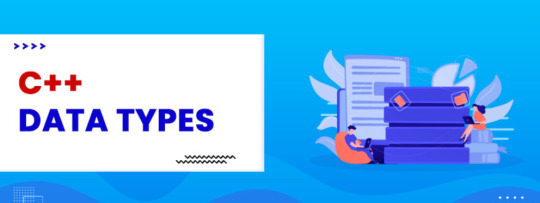
0 notes
Text
JavaScript Fundamentals
I have recently completed a course that extensively covered the foundational principles of JavaScript, and I'm here to provide you with a concise overview. This post will enable you to grasp the fundamental concepts without the need to enroll in the course.
Prerequisites: Fundamental HTML Comprehension
Before delving into JavaScript, it is imperative to possess a basic understanding of HTML. Knowledge of CSS, while beneficial, is not mandatory, as it primarily pertains to the visual aspects of web pages.
Manipulating HTML Text with JavaScript
When it comes to modifying text using JavaScript, the innerHTML function is the go-to tool. Let's break down the process step by step:
Initiate the process by selecting the HTML element whose text you intend to modify. This selection can be accomplished by employing various DOM (Document Object Model) element selection methods offered by JavaScript ( I'll talk about them in a second )
Optionally, you can store the selected element in a variable (we'll get into variables shortly).
Employ the innerHTML function to substitute the existing text with your desired content.
Element Selection: IDs or Classes
You have the opportunity to enhance your element selection by assigning either an ID or a class:
Assigning an ID:
To uniquely identify an element, the .getElementById() function is your go-to choice. Here's an example in HTML and JavaScript:
HTML:
<button id="btnSearch">Search</button>
JavaScript:
document.getElementById("btnSearch").innerHTML = "Not working";
This code snippet will alter the text within the button from "Search" to "Not working."
Assigning a Class:
For broader selections of elements, you can assign a class and use the .querySelector() function. Keep in mind that this method can select multiple elements, in contrast to .getElementById(), which typically focuses on a single element and is more commonly used.
Variables
Let's keep it simple: What's a variable? Well, think of it as a container where you can put different things—these things could be numbers, words, characters, or even true/false values. These various types of stuff that you can store in a variable are called DATA TYPES.
Now, some programming languages are pretty strict about mentioning these data types. Take C and C++, for instance; they're what we call "Typed" languages, and they really care about knowing the data type.
But here's where JavaScript stands out: When you create a variable in JavaScript, you don't have to specify its data type or anything like that. JavaScript is pretty laid-back when it comes to data types.
So, how do you make a variable in JavaScript?
There are three main keywords you need to know: var, let, and const.
But if you're just starting out, here's what you need to know :
const: Use this when you want your variable to stay the same, not change. It's like a constant, as the name suggests.
var and let: These are the ones you use when you're planning to change the value stored in the variable as your program runs.
Note that var is rarely used nowadays
Check this out:
let Variable1 = 3; var Variable2 = "This is a string"; const Variable3 = true;
Notice how we can store all sorts of stuff without worrying about declaring their types in JavaScript. It's one of the reasons JavaScript is a popular choice for beginners.
Arrays
Arrays are a basically just a group of variables stored in one container ( A container is what ? a variable , So an array is also just a variable ) , now again since JavaScript is easy with datatypes it is not considered an error to store variables of different datatypeslet
for example :
myArray = [1 , 2, 4 , "Name"];
Objects in JavaScript
Objects play a significant role, especially in the world of OOP : object-oriented programming (which we'll talk about in another post). For now, let's focus on understanding what objects are and how they mirror real-world objects.
In our everyday world, objects possess characteristics or properties. Take a car, for instance; it boasts attributes like its color, speed rate, and make.
So, how do we represent a car in JavaScript? A regular variable won't quite cut it, and neither will an array. The answer lies in using an object.
const Car = { color: "red", speedRate: "200km", make: "Range Rover" };
In this example, we've encapsulated the car's properties within an object called Car. This structure is not only intuitive but also aligns with how real-world objects are conceptualized and represented in JavaScript.
Variable Scope
There are three variable scopes : global scope, local scope, and function scope. Let's break it down in plain terms.
Global Scope: Think of global scope as the wild west of variables. When you declare a variable here, it's like planting a flag that says, "I'm available everywhere in the code!" No need for any special enclosures or curly braces.
Local Scope: Picture local scope as a cozy room with its own rules. When you create a variable inside a pair of curly braces, like this:
//Not here { const Variable1 = true; //Variable1 can only be used here } //Neither here
Variable1 becomes a room-bound secret. You can't use it anywhere else in the code
Function Scope: When you declare a variable inside a function (don't worry, we'll cover functions soon), it's a member of an exclusive group. This means you can only name-drop it within that function. .
So, variable scope is all about where you place your variables and where they're allowed to be used.
Adding in user input
To capture user input in JavaScript, you can use various methods and techniques depending on the context, such as web forms, text fields, or command-line interfaces.We’ll only talk for now about HTML forms
HTML Forms:
You can create HTML forms using the <;form> element and capture user input using various input elements like text fields, radio buttons, checkboxes, and more.
JavaScript can then be used to access and process the user's input.
Functions in JavaScript
Think of a function as a helpful individual with a specific task. Whenever you need that task performed in your code, you simply call upon this capable "person" to get the job done.
Declaring a Function: Declaring a function is straightforward. You define it like this:
function functionName() { // The code that defines what the function does goes here }
Then, when you need the function to carry out its task, you call it by name:
functionName();
Using Functions in HTML: Functions are often used in HTML to handle events. But what exactly is an event? It's when a user interacts with something on a web page, like clicking a button, following a link, or interacting with an image.
Event Handling: JavaScript helps us determine what should happen when a user interacts with elements on a webpage. Here's how you might use it:
HTML:
<button onclick="FunctionName()" id="btnEvent">Click me</button>
JavaScript:
function FunctionName() { var toHandle = document.getElementById("btnEvent"); // Once I've identified my button, I can specify how to handle the click event here }
In this example, when the user clicks the "Click me" button, the JavaScript function FunctionName() is called, and you can specify how to handle that event within the function.
Arrow functions : is a type of functions that was introduced in ES6, you can read more about it in the link below
If Statements
These simple constructs come into play in your code, no matter how advanced your projects become.
If Statements Demystified: Let's break it down. "If" is precisely what it sounds like: if something holds true, then do something. You define a condition within parentheses, and if that condition evaluates to true, the code enclosed in curly braces executes.
If statements are your go-to tool for handling various scenarios, including error management, addressing specific cases, and more.
Writing an If Statement:
if (Variable === "help") { console.log("Send help"); // The console.log() function outputs information to the console }
In this example, if the condition inside the parentheses (in this case, checking if the Variable is equal to "help") is true, the code within the curly braces gets executed.
Else and Else If Statements
Else: When the "if" condition is not met, the "else" part kicks in. It serves as a safety net, ensuring your program doesn't break and allowing you to specify what should happen in such cases.
Else If: Now, what if you need to check for a particular condition within a series of possibilities? That's where "else if" steps in. It allows you to examine and handle specific cases that require unique treatment.
Styling Elements with JavaScript
This is the beginner-friendly approach to changing the style of elements in JavaScript. It involves selecting an element using its ID or class, then making use of the .style.property method to set the desired styling property.
Example:
Let's say you have an HTML button with the ID "myButton," and you want to change its background color to red using JavaScript. Here's how you can do it:
HTML: <button id="myButton">Click me</button>
JavaScript:
// Select the button element by its ID const buttonElement = document.getElementById("myButton"); // Change the background color property buttonElement.style.backgroundColor = "red";
In this example, we first select the button element by its ID using document.getElementById("myButton"). Then, we use .style.backgroundColor to set the background color property of the button to "red." This straightforward approach allows you to dynamically change the style of HTML elements using JavaScript.
#studyblr#code#codeblr#css#html#javascript#java development company#python#study#progblr#programming#studying#comp sci#web design#web developers#web development#website design#ui ux design#reactjs#webdev#website#tech
400 notes
·
View notes
Text
i found some of the features of Rust a bit odd: the enums with types and values, the pattern-matching, the let statements. they are nice! but why did these seem like natural changes? i thought of the language as 'C++ with functional features and careful memory management', and the archetypical functional language for me is Scheme. Rust does not look like an interpolation of C and Scheme. recently, i've been learning Standard ML, and now i see where all of these features come from. an enum is just a datatype; the let statements are just the same as ML's; if let is just ML case ... of ...; there are probably more examples
these features seem less surprising after encountering them together in another context
10 notes
·
View notes
Text
This Week in Rust 518
Hello and welcome to another issue of This Week in Rust! Rust is a programming language empowering everyone to build reliable and efficient software. This is a weekly summary of its progress and community. Want something mentioned? Tag us at @ThisWeekInRust on Twitter or @ThisWeekinRust on mastodon.social, or send us a pull request. Want to get involved? We love contributions.
This Week in Rust is openly developed on GitHub and archives can be viewed at this-week-in-rust.org. If you find any errors in this week's issue, please submit a PR.
Updates from Rust Community
Project/Tooling Updates
Strobe Crate
System dependencies are hard (so we made them easier)
Observations/Thoughts
Trying to invent a better substring search algorithm
Improving Node.js with Rust-Wasm Library
Mixing C# and Rust - Interop
A fresh look on incremental zero copy serialization
Make the Rust compiler 5% faster with this one weird trick
Part 3: Rowing Afloat Datatype Boats
Recreating concurrent futures combinators in smol
Unpacking some Rust ergonomics: getting a single Result from an iterator of them
Idea: "Using Rust", a living document
Object Soup is Made of Indexes
Analyzing Data 180,000x Faster with Rust
Issue #10: Serving HTML
Rust vs C on an ATTiny85; an embedded war story
Rust Walkthroughs
Analyzing Data /,000x Faster with Rust
Fully Automated Releases for Rust Projects
Make your Rust code unit testable with dependency inversion
Nine Rules to Formally Validate Rust Algorithms with Dafny (Part 2): Lessons from Verifying the range-set-blaze Crate
[video] Let's write a message broker using QUIC - Broke But Quick Episode 1
[video] Publishing Messages over QUIC Streams!! - Broke But Quick episode 2
Miscellaneous
[video] Associated types in Iterator bounds
[video] Rust and the Age of High-Integrity Languages
[video] Implementing (part of) a BitTorrent client in Rust
Crate of the Week
This week's crate is cargo-show-asm, a cargo subcommand to show the optimized assembly of any function.
Thanks to Kornel for the suggestion!
Please submit your suggestions and votes for next week!
Call for Participation
Always wanted to contribute to open-source projects but did not know where to start? Every week we highlight some tasks from the Rust community for you to pick and get started!
Some of these tasks may also have mentors available, visit the task page for more information.
* Hyperswitch (Hacktoberfest)- [FEATURE] separate payments_session from payments core * Hyperswitch (Hacktoberfest)- [NMI] Use connector_response_reference_id as reference to merchant * Hyperswitch (Hacktoberfest)- [Airwallex] Use connector_response_reference_id as reference to merchant * Hyperswitch (Hacktoberfest)- [Worldline] Use connector_response_reference_id as reference to merchant * Ockam - Make ockam project delete (no args) interactive by asking the user to choose from a list of space and project names to delete (tuify) * Ockam - Validate CBOR structs according to the cddl schema for authenticator/direct/types * Ockam - Slim down the NodeManagerWorker for node / node status
If you are a Rust project owner and are looking for contributors, please submit tasks here.
Updates from the Rust Project
397 pull requests were merged in the last week
rewrite gdb pretty-printer registration
add FileCheck annotations to mir-opt tests
add MonoItems and Instance to stable_mir
add a csky-unknown-linux-gnuabiv2hf target
add a test showing failing closure signature inference in new solver
add new simpler and more explicit syntax for check-cfg
add stable Instance::body() and RustcInternal trait
automatically enable cross-crate inlining for small functions
avoid a track_errors by bubbling up most errors from check_well_formed
avoid having rustc_smir depend on rustc_interface or rustc_driver
coverage: emit mappings for unused functions without generating stubs
coverage: emit the filenames section before encoding per-function mappings
coverage: fix inconsistent handling of function signature spans
coverage: move most per-function coverage info into mir::Body
coverage: simplify the injection of coverage statements
disable missing_copy_implementations lint on non_exhaustive types
do not bold main message in --error-format=short
don't ICE when encountering unresolved regions in fully_resolve
don't compare host param by name
don't crash on empty match in the nonexhaustive_omitted_patterns lint
duplicate ~const bounds with a non-const one in effects desugaring
eliminate rustc_attrs::builtin::handle_errors in favor of emitting errors directly
fix a performance regression in obligation deduplication
fix implied outlives check for GAT in RPITIT
fix spans for removing .await on for expressions
fix suggestion for renamed coroutines feature
implement an internal lint encouraging use of Span::eq_ctxt
implement jump threading MIR opt
implement rustc part of RFC 3127 trim-paths
improve display of parallel jobs in rustdoc-gui tester script
initiate the inner usage of cfg_match (Compiler)
lint non_exhaustive_omitted_patterns by columns
location-insensitive polonius: consider a loan escaping if an SCC has member constraints applied only
make #[repr(Rust)] incompatible with other (non-modifier) representation hints like C and simd
make rustc_onunimplemented export path agnostic
mention into_iter on borrow errors suggestions when appropriate
mention the syntax for use on mod foo; if foo doesn't exist
panic when the global allocator tries to register a TLS destructor
point at assoc fn definition on type param divergence
preserve unicode escapes in format string literals when pretty-printing AST
properly account for self ty in method disambiguation suggestion
report unused_import for empty reexports even it is pub
special case iterator chain checks for suggestion
strict provenance unwind
suggest ; after bare match expression E0308
suggest constraining assoc types in more cases
suggest relaxing implicit type Assoc: Sized; bound
suggest removing redundant arguments in format!()
uplift movability and mutability, the simple way
miri: avoid a linear scan over the entire int_to_ptr_map on each deallocation
miri: fix rounding mode check in SSE4.1 round functions
miri: intptrcast: remove information about dead allocations
disable effects in libcore again
add #[track_caller] to Option::unwrap_or_else
specialize Bytes<R>::next when R is a BufReader
make TCP connect handle EINTR correctly
on Windows make read_dir error on the empty path
hashbrown: add low-level HashTable API
codegen_gcc: add support for NonNull function attribute
codegen_gcc: fix #[inline(always)] attribute and support unsigned comparison for signed integers
codegen_gcc: fix endianness
codegen_gcc: fix int types alignment
codegen_gcc: optimize popcount implementation
codegen_gcc: optimize u128/i128 popcounts further
cargo add: Preserve more comments
cargo remove: Preserve feature comments
cargo replace: Partial-version spec support
cargo: Provide next steps for bad -Z flag
cargo: Suggest cargo-search on bad commands
cargo: adjust -Zcheck-cfg for new rustc syntax and behavior
cargo: if there's a version in the lock file only use that exact version
cargo: make the precise field of a source an Enum
cargo: print environment variables for build script executions with -vv
cargo: warn about crate name's format when creating new crate
rustdoc: align stability badge to baseline instead of bottom
rustdoc: avoid allocating strings primitive link printing
clippy: map_identity: allow closure with type annotations
clippy: map_identity: recognize tuple identity function
clippy: add lint for struct field names
clippy: don't emit needless_pass_by_ref_mut if the variable is used in an unsafe block or function
clippy: make multiple_unsafe_ops_per_block ignore await desugaring
clippy: needless pass by ref mut closure non async fn
clippy: now declare_interior_mutable_const and borrow_interior_mutable_const respect the ignore-interior-mutability configuration entry
clippy: skip if_not_else lint for '!= 0'-style checks
clippy: suggest passing function instead of calling it in closure for option_if_let_else
clippy: warn missing_enforced_import_renames by default
rust-analyzer: generate descriptors for all unstable features
rust-analyzer: add command for only opening external docs and attempt to fix vscode-remote issue
rust-analyzer: add incorrect case diagnostics for module names
rust-analyzer: fix VS Code detection for Insiders version
rust-analyzer: import trait if needed for unqualify_method_call assist
rust-analyzer: pick a better name for variables introduced by replace_is_some_with_if_let_some
rust-analyzer: store binding mode for each instance of a binding independently
perf: add NES emulation runtime benchmark
Rust Compiler Performance Triage
Approved RFCs
Changes to Rust follow the Rust RFC (request for comments) process. These are the RFCs that were approved for implementation this week:
Add f16 and f128 float types
Unicode and escape codes in literals
Final Comment Period
Every week, the team announces the 'final comment period' for RFCs and key PRs which are reaching a decision. Express your opinions now.
RFCs
No RFCs entered Final Comment Period this week.
Tracking Issues & PRs
[disposition: merge] Consider alias bounds when computing liveness in NLL (but this time sound hopefully)
[disposition: close] regression: parameter type may not live long enough
[disposition: merge] Remove support for compiler plugins.
[disposition: merge] rustdoc: Document lack of object safety on affected traits
[disposition: merge] Stabilize Ratified RISC-V Target Features
[disposition: merge] Tracking Issue for const mem::discriminant
New and Updated RFCs
[new] eRFC: #[should_move] attribute for per-function opting out of Copy semantics
Call for Testing
An important step for RFC implementation is for people to experiment with the implementation and give feedback, especially before stabilization. The following RFCs would benefit from user testing before moving forward:
No RFCs issued a call for testing this week.
If you are a feature implementer and would like your RFC to appear on the above list, add the new call-for-testing label to your RFC along with a comment providing testing instructions and/or guidance on which aspect(s) of the feature need testing.
Upcoming Events
Rusty Events between 2023-10-25 - 2023-11-22 🦀
Virtual
2023-10-30 | Virtual (Melbourne, VIC, AU) | Rust Melbourne
(Hybrid - online & in person) October 2023 Rust Melbourne Meetup
2023-10-31 | Virtual (Europe / Africa) | Rust for Lunch
Rust Meet-up
2023-11-01 | Virtual (Cardiff, UK)| Rust and C++ Cardiff
ECS with Bevy Game Engine
2023-11-01 | Virtual (Indianapolis, IN, US) | Indy Rust
Indy.rs - with Social Distancing
2023-11-02 | Virtual (Charlottesville, NC, US) | Charlottesville Rust Meetup
Crafting Interpreters in Rust Collaboratively
2023-11-07 | Virtual (Berlin, DE) | OpenTechSchool Berlin
Rust Hack and Learn | Mirror
2023-11-07 | Virtual (Buffalo, NY, US) | Buffalo Rust Meetup
Buffalo Rust User Group, First Tuesdays
2023-11-09 | Virtual (Nuremberg, DE) | Rust Nuremberg
Rust Nürnberg online
2023-11-14 | Virtual (Dallas, TX, US) | Dallas Rust
Second Tuesday
2023-11-15 | Virtual (Cardiff, UK)| Rust and C++ Cardiff
Building Our Own Locks (Atomics & Locks Chapter 9)
2023-11-15 | Virtual (Richmond, VA, US) | Linux Plumbers Conference
Rust Microconference in LPC 2023 (Nov 13-16)
2023-11-15 | Virtual (Vancouver, BC, CA) | Vancouver Rust
Rust Study/Hack/Hang-out
2023-11-16 | Virtual (Charlottesville, NC, US) | Charlottesville Rust Meetup
Crafting Interpreters in Rust Collaboratively
2023-11-07 | Virtual (Berlin, DE) | OpenTechSchool Berlin
Rust Hack and Learn | Mirror
2023-11-21 | Virtual (Washington, DC, US) | Rust DC
Mid-month Rustful
Europe
2023-10-25 | Dublin, IE | Rust Dublin
Biome, web development tooling with Rust
2023-10-25 | Paris, FR | Rust Paris
Rust for the web - Paris meetup #61
2023-10-25 | Zagreb, HR | impl Zagreb for Rust
Rust Meetup 2023/10: Lunatic
2023-10-26 | Augsburg, DE | Rust - Modern Systems Programming in Leipzig
Augsburg Rust Meetup #3
2023-10-26 | Copenhagen, DK | Copenhagen Rust Community
Rust metup #41 sponsored by Factbird
2023-10-26 | Delft, NL | Rust Nederland
Rust at TU Delft
2023-10-26 | Lille, FR | Rust Lille
Rust Lille #4 at SFEIR
2022-10-30 | Stockholm, SE | Stockholm Rust
Rust Meetup @Aira + Netlight
2023-11-01 | Cologne, DE | Rust Cologne
Web-applications with axum: Hello CRUD!
2023-11-07 | Bratislava, SK | Bratislava Rust Meetup Group
Rust Meetup by Sonalake
2023-11-07 | Brussels, BE | Rust Aarhus
Rust Aarhus - Rust and Talk beginners edition
2023-11-07 | Lyon, FR | Rust Lyon
Rust Lyon Meetup #7
2023-11-09 | Barcelona, ES | BcnRust
11th BcnRust Meetup
2023-11-09 | Reading, UK | Reading Rust Workshop
Reading Rust Meetup at Browns
2023-11-21 | Augsburg, DE | Rust - Modern Systems Programming in Leipzig
GPU processing in Rust
2023-11-23 | Biel/Bienne, CH | Rust Bern
Rust Talks Bern @ Biel: Embedded Edition
North America
2023-10-25 | Austin, TX, US | Rust ATX
Rust Lunch - Fareground
2023-10-25 | Chicago, IL, US | Deep Dish Rust
Rust Happy Hour
2023-11-01 | Brookline, MA, US | Boston Rust Meetup
Boston Common Rust Lunch
2023-11-08 | Boulder, CO, US | Boulder Rust Meetup
Let's make a Discord bot!
2023-11-14 | New York, NY, US | Rust NYC
Rust NYC Monthly Mixer: Share, Show, & Tell! 🦀
2023-11-14 | Seattle, WA, US | Cap Hill Rust Coding/Hacking/Learning
Rusty Coding/Hacking/Learning Night
2023-11-15 | Richmond, VA, US + Virtual | Linux Plumbers Conference
Rust Microconference in LPC 2023 (Nov 13-16)
2023-11-16 | Nashville, TN, US | Music City Rust Developers
Python loves Rust!
2023-11-16 | Seattle, WA, US | Seattle Rust User Group
Seattle Rust User Group Meetup
2023-11-21 | San Francisco, CA, US | San Francisco Rust Study Group
Rust Hacking in Person
2023-11-22 | Austin, TX, US | Rust ATX
Rust Lunch - Fareground
Oceania
2023-10-26 | Brisbane, QLD, AU | Rust Brisbane
October Meetup
2023-10-30 | Melbourne, VIC, AU + Virtual | Rust Melbourne
(Hybrid - in person & online) October 2023 Rust Melbourne Meetup
2023-11-21 | Christchurch, NZ | Christchurch Rust Meetup Group
Christchurch Rust meetup meeting
If you are running a Rust event please add it to the calendar to get it mentioned here. Please remember to add a link to the event too. Email the Rust Community Team for access.
Jobs
Please see the latest Who's Hiring thread on r/rust
Quote of the Week
When your Rust build times get slower after adding some procedural macros:
We call that the syn tax :ferris:
– Janet on Fosstodon
Thanks to Jacob Pratt for the suggestion!
Please submit quotes and vote for next week!
This Week in Rust is edited by: nellshamrell, llogiq, cdmistman, ericseppanen, extrawurst, andrewpollack, U007D, kolharsam, joelmarcey, mariannegoldin, bennyvasquez.
Email list hosting is sponsored by The Rust Foundation
Discuss on r/rust
9 notes
·
View notes
Text
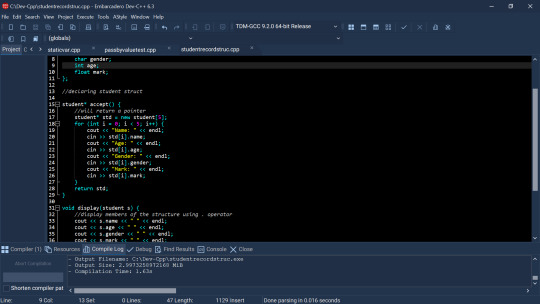
day 3 of 30 days of code
functions practice as usual, and structures (they're fun, it's cool to make your own datatype). and i ditched vs community in favour of dev c++ because it was being weird and not compiling some programs and i didn't want to waste time trying to figure it out.
3 notes
·
View notes
Text
Immediate Matrix: Your Guide to Smart Trading Decisions

Trading, whether it's stocks or cryptocurrencies, has become a popular way for many people to make money. A new platform called Immediate Matrix says that its many features make it one of the best choices for traders who want to possibly make a lot of money. Some people who have only recently heard of the app may not know if it is real, though. To help you with this, we will carefully look over Immediate Matrix and rate every part of the platform to get a sense of how real it is as a trade platform.
✅ Trading App Name ╰┈➤ Immediate Matrix ⭐
✅ Offer Type ╰┈➤ Crypto ₿
✅ Traffic Cap ╰┈➤ N/A ❌
✅ Target Market ╰┈➤ Male and Female- 18-60+ years 👨🏼🤝👨🏻
✅ Investment ╰┈➤ $250 First Deposit 💰
✅ Fee ╰┈➤ No 🙅♂️
꧁༺✨❗Buy Now ❗✨༻꧂
https://www.offerplox.com/get-Immediate-Matrix
꧁༺✨❗ Official Facebook ❗✨༻꧂
https://www.facebook.com/groups/theimmediatematrix
꧁༺✨❗Shop Now ❗✨༻꧂
https://immediatematrix.company.site/
What Is Immediate Matrix?
Arrays, datatypes, and stored procedure snowflakes are used by this program to make trade execution more efficient. Price gaps or margins can be used to get or suggest order types with little risk. This is the idea behind the technology. What does it all mean? In simple words, it means that the technology that runs Immediate Matrix makes the things that happen behind the scenes faster and better.
💰 Click Here To Trade With Immediate Matrix For Free 🤑
All of this is done to raise the success rate so that members can get more benefits. Also, it's important to note that Immediate Matrix uses Python, Lisp, and Julia code. That being said, these programming languages, along with JavaScript and C++, are the most widely linked to AI development. Furthermore, AI sequence methods are used in real time for predictive analysis, along with formulas from combinatorial mathematics.
How Does Immediate Matrix Work?
Many people are interested in the Immediate Matrix Reviews because it has many analytical tools that can help users make important trading decisions that could lead to lucrative chances. There isn't much to talk about when it comes to how the platform works since the project doesn't include a trading robot or other features that make dealing easier for users.
We also couldn't find any details about the software and algorithms that were used to make the trading platform. In fact, buyers who sign up as users are the only ones who can even get to the dashboard that the website talks about. The platform's signup process seems to be as easy as it gets, since there is no Know Your Customer (KYC) step.
The trading charts, indicators, and other similar tools, on the other hand, look like they were made by the people who made the program and not by someone else. This means that users will be able to reach a platform that is better tailored to their needs.
Who Created Immediate Matrix?
As we looked into the platform, we found on a number of outside websites that the Immediate Matrix platform was created by a group of well-known and powerful people in the banking and blockchain industries. We did not find any proof, though, that such a group was behind the project. It looks like the developers decided to stay anonymous, which is common in the cryptocurrency world these days.
Immediate Matrix Features
Here are some of the most important parts of the Immediate Matrix program. The app is very far ahead of its time in the crypto space thanks to these abilities.
💰 Click Here To Trade With Immediate Matrix For Free 🤑
Strategy Tester
The Immediate Matrix Platform has a built-in strategy tester that lets traders test their favorite trading methods both in the past and in the future. Crypto traders can use the strategy tester tool to make their trading strategies better after setting their own preferences.
Demo Trading
Traders can use the demo account that comes with this advanced trading tool to try and improve their trading strategies before using it to trade with real money. People who trade on demo accounts can also learn how Immediate Matrix works.
High Customization
There are a lot of ways to change the Immediate Matrix program so that traders can have full control over their trading. Traders and buyers can change things about trading, such as the coins that can be traded, the amount staked, the trading times, the stop loss and take profit levels, and more. There is also room to switch between automated and manual trade modes in Immediate Matrix.
Demo Account
All Immediate Matrix partner brokers give all traders and buyers a free demo account that they can use as much as they want. This means that traders can test how well the software works and improve their trading skills before putting money into it for good.
Advanced Strategy
The Immediate Matrix trading software uses both advanced technical and fundamental methods to make sure that trades in the cryptocurrency markets are always correct. The app uses built-in artificial intelligence (AI) to figure out how people feel about the crypto market as a whole so that traders can make money in both trending and non-trending situations.
Automated Software
Based on coded algorithms, this cutting-edge training software helps people deal on the cryptocurrency market. Because it is automatic, investors don't need to do anything. The software does have a manual trading mode, though, which lets traders handle their accounts and take charge of their trading.
Safety
Immediate Matrix Software makes sure that its traders are safe by using the best security standards. People who trade in Bitcoin and its partner brokers help keep their money and personal information safe at all times. Immediate Matrix cares very much about the safety and security of its buyers.
How To Use Immediate Matrix?
If you're still interested in the site after reading the review, here's how to start trading on Immediate Matrix:
💰 Click Here To Trade With Immediate Matrix For Free 🤑
Step 1 – Visit the Immediate Matrix Website
Go to the official Immediate Matrix website and start the signup process to get things going. Giving simple information like your name, email address, and phone number is usually what this means.
Step 2 – Make the Minimum Deposit
After setting up and verifying your account, it's time to make your first payment. Before you can get to the screen, you have to do this. Several payment methods, such as credit cards and e-wallets that are accepted, can be used to add money to your account.
Step 3 – Start Trading with Immediate Matrix
Now that the deposit is complete, you can look at the different cryptocurrencies, buy in one, and start trading on the platform.
How Is Immediate Matrix Different Than Other Trading Apps?
Immediate Matrix is a platform for trading and getting tips about cryptocurrencies. It lets users customize alerts and signals for different cryptocurrencies. Here are some things that might make the Immediate Matrix trade app stand out or be important features:
Customizable Alerts: Stay up to date on important changes in the bitcoin market.
User-Friendly Interface: means a system that is easy for new or inexperienced users to use.
Market Data Aggregation: Immediate Matrix collects market data from different coin exchanges and makes it available.
Portfolio Tracking: The app has tools for portfolio tracking that let users see how their trades are doing.
Real-Time Notifications: Immediate Matrix wants to send real-time alerts when certain conditions are met.
Is Immediate Matrix a Scam?
It's not easy to say for sure whether Immediate Matrix Registration is a scam or a real cryptocurrency trading site. Many people are worried about the platform because they can't find much information about it before they put money, which is not ideal.
It also doesn't look like there are any clear social media names or other ways to get in touch with the platform before you make the minimum deposit and sign up. Even though Immediate Matrix makes bold claims about what it can do, it doesn't quite back them up with solid proof.
💰 Click Here To Trade With Immediate Matrix For Free 🤑
It is hard to make a firm decision about the platform because there isn't enough solid information to compare it to. Taking all of this into account, people who want to use the Immediate Matrix platform should be very careful and carefully consider their choices before they start trading.
Immediate Matrix Cost, Investment & Estimated Profit
You can use the Immediate Matrix Trading App for free. Traders only need to sign up and wait for approval from the team before they can use their account. You need to put at least $250 into your account before you can start betting. There are no fees to transfer money, withdraw money, or use Immediate Matrix's broking services. So, the only cost you have to pay is the money you put in to start trading. If you trade wisely, you can later make huge gains.
Conclusion
We did everything we could to find and analyze all the information we could find about Immediate Matrix. Although it advertises itself as a promising trading tool, there isn't much proof to back up its claims. It is very hard to tell if Immediate Matrix Official Website is real because there isn't enough solid information and data available.
We also saw that the site didn't have many reviews or comments from trustworthy sources. Because of these things, we highly advise that all users be very careful and do a lot of research before they open an Immediate Matrix account to trade.
ImmediateMatrix
ImmediateMatrixReviews
ImmediateMatrixPlatform
ImmediateMatrixSoftware
ImmediateMatrixLogin
ImmediateMatrixOfficialWebsite
ImmediateMatrixRegistration
ImmediateMatrixTrading
ImmediateMatrixApp
ImmediateMatrix2024
ImmediateMatrixLegit
ImmediateMatrixScam
ImmediateMatrixInvestment
ImmediateMatrixReal
ImmediateMatrixWealth
ImmediateMatrixDetails
ImmediateMatrixPlatformReviews
1 note
·
View note
Video
youtube
STD::VARIANT IN C++17 | STORE DIFFERENT DATATYPES
0 notes
Text
PyTorch 2.5: Leveraging Intel AMX For Faster FP16 Inference

Intel Advances AI Development through PyTorch 2.5 Contributions
New features broaden support for Intel GPUs and improve the development experience for AI developers across client and data center hardware.
PyTorch 2.5 supports new Intel data center CPUs. Inference capabilities on Intel Xeon 6 processors are improved by Intel Advanced Matrix Extensions(Intel AMX) for eager mode and TorchInductor, which enable and optimize the FP16 datatype. Windows AI developers can use the TorchInductor C++ backend for a better experience.
Intel Advanced Matrix Extensions(Intel AMX)
Overview of Intel Advanced Matrix Extensions (Intel AMX) to fulfill the computational needs of deep learning workloads, Intel Corporation AMX extends and speeds up AI capabilities. The Intel Xeon Scalable CPUs come with this inbuilt accelerator.
Use Intel AMX to Speed Up AI Workloads
A new built-in accelerator called Intel AMX enhances deep learning training and inference performance on the CPU, making it perfect for tasks like image recognition, recommendation systems, and natural language processing.
What is Intel AMX?
Your AI performance is improved and made simpler using Intel AMX. Designed to meet the computational demands of deep learning applications, it is an integrated accelerator on Intel Xeon Scalable CPUs.
AI Inference Performance Enhancement
Improvement of AI Inference Performance Fourth-generation Intel Xeon Scalable processors with Intel AMX and optimization tools were used by Alibaba Cloud‘s machine learning platform (PAI). When compared to the prior generation, this enhanced end-to-end inferencing.
Optimizing Machine Learning (ML) Models
Improving Models for Machine Learning (ML)Throughput increases using the BERT paradigm over the previous generation were shown by Intel and Tencent using Intel AMX. Tencent lowers total cost of ownership (TCO) and provides better services because to the streamlined BERT model.
Accelerate AI with Intel Advanced Matrix Extensions
Use Intel Advanced Matrix Extensions to Speed Up AI. AI applications benefit from Intel AMX’s performance and power efficiency. It is an integrated accelerator specifically designed for Intel Xeon Scalable CPUs.
PyTorch 2.5
PyTorch 2.5, which was recently published with contributions from Intel, offers artificial intelligence (AI) developers enhanced support for Intel GPUs. Supported GPUs include the Intel Data Center GPU Max Series, Intel Arc discrete graphics, and Intel Core Ultra CPUs with integrated Intel Arc graphics.
These new capabilities provide a uniform developer experience and support, and they aid in accelerating machine learning processes inside the PyTorch community. PyTorch with preview and nightly binary releases for Windows, Linux, and Windows Subsystem for Linux 2 may now be installed directly on Intel Core Ultra AI PCs for researchers and application developers looking to refine, infer, and test PyTorch models.
What is PyTorch 2.5?
A version of the well-known PyTorch open-source machine learning framework is called PyTorch 2.5.
New Featuers of PyTorch 2.5
CuDNN Backend for SDPA: SDPA users with H100s or more recent GPUs may benefit from speedups by default with to the CuDNN Backend for SDPA.
Increased GPU Support: PyTorch 2.5 now supports Intel GPUs and has additional tools to enhance AI programming on client and data center hardware.
Torch Compile Improvements: For a variety of deep learning tasks, Torch.compile has been improved to better inference and training performance.
FP16 Datatype Optimization: Intel Advanced Matrix Extensions for TorchInductor and eager mode enable and optimize the FP16 datatype, improving inference capabilities on the newest Intel data center CPU architectures.
TorchInductor C++ Backend: Now accessible on Windows, the TorchInductor C++ backend improves the user experience for AI developers working in Windows settings.
SYCL Kernels: By improving Aten operator coverage and execution on Intel GPUs, SYCL kernels improve PyTorch eager mode performance.
Binary Releases: PyTorch 2.5 makes it simpler for developers to get started by offering preview and nightly binary releases for Windows, Linux, and Windows Subsystem for Linux 2.Python >= 3.9 and C++ <= 14 are supported by PyTorch 2.5.
Read more on govindhtech.com
#PyTorch25#LeveragingIntelAMX#intel#IntelXeon#FasterFP16Inference#AlibabaCloud#PyTorch#MachineLearning#ML#IntelGPU#ai#gpu#MachineLearningModels#technology#technews#news#govindhtech
0 notes
Text
OverflowError: Python int too large to convert to C long
A datatype with date format was tried to converted to an integer , but due to the size of the integer, there was an overflow error. ddate = df['dat'].astype('int') return arr.astype(dtype, copy=True) OverflowError: Python int too large to convert to C long try: ddate = df['dat'].astype('int') except OverflowError: ddate = df['dat'].astype('int64')
0 notes
Text
youtube
C++ Boolean DataType in Hindi | What is Boolean Data Type in C++ | C++ Tutorials
In C++, the bool data type is used to store Boolean values, which can be either true or false. This data type is commonly used in conditional statements and loops to represent binary states (true/false, yes/no, 1/0). For more details, Kindly check my website URL. https://www.removeload.com/cpp-boolean
0 notes
Text
Python Unveiled: A Beginner's Odyssey into the World of Coding Magic
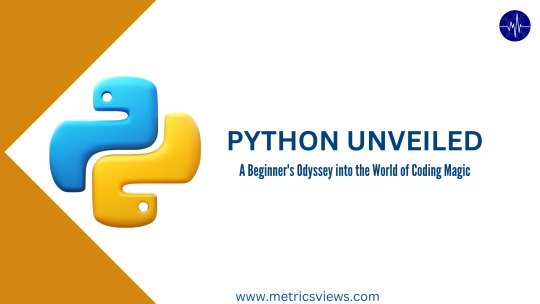
Installation:
Visit the official Python website: https://www.python.org/downloads/windows/
Click the appropriate link for your system to download the executable file: Windows installer (64-bit) or Windows installer (32-bit).
Run that downloaded executable installer file. For example, python.exe file.
Click Install to start the installation.
After the installation is complete, a Setup was successful message is displays.
To verify python installation:
Enter the code: python --version

Now you are ready to start learning and programming in Python.
Quick Summary:
Python has syntax that allows developers to write programs with less lines than some other programming languages. Python runs on an interpreter system. Python is a computer programming language often used to build websites and software, applications ,conduct data analysis.
Targeted Audience:
This article is intended for those people interested in learning the fundamentals of python development. It will be useful for freshers, backend developers, students. and for those who are lazy to write lengthy code because python has easy, simple syntax which includes short code.
Use Cases:
Web development -framework: Django, Flask, FastAPI, etc.
Data analysis - Pandas, NumPy
Game development - Pygame
Education and teaching programming concepts
Let’s see what Python is:
Definition:
Python is a high-level, general-purpose, interpreted object-oriented programming language and it is used to build websites and software.
Python code tends to be short and when compared to compiled languages like C and C++, it executes programs slower.
Features:
Easy to Learn and Use:
Python is easy to learn and simple as compared to other languages. Its syntax is straightforward.
There is no use of the semicolon or curly-bracket in syntax.
It is the most suggested programming language for beginners.
Interpreted Language:
Interpreted means program executes single line at a time.
The advantage of being interpreted language, makes it debugging easy and portable.
Expressive Language:
For Ex.: If you want to print small program you simply type print ("Hello World"). It will take only single line to execute, while Java or C takes multiple lines.
Free and Open Source:
Python is freely available for everyone. open-source means, "Anyone can download its source code without paying a single rupee.
Object-Oriented Language:
Python supports object-oriented language and concepts of classes and objects. It supports inheritance, polymorphism, and encapsulation, etc.
Syntax:
demo.py :- File name

How to run python file:
python myfile.py // here my myfile is name of program.

Python Comments:
Comments are often used to explain Python code. "#" used for commenting.
For Ex: # Printing hello world

Variables:
Variables are like containers it stores data values.
For Ex: x = 5 //x is a variable

Data Types:
String: In String datatype, we can store string values.

int: In int datatype, we can store int values.

float: In float datatype, we can store float values.

list: lists are always stored in square brackets [ ] .

tuple: tuples are always stored in round brackets ( ) .

dict: In Dictionaries, we store key value pair.

Function:
A function is a reusable block of code that performs some specific tasks. it only runs when it is called.
You can pass data, known as parameters in a function.
here : demo_function is function name. It can be anything.

Arrays:
Arrays are used to store multiple values but with same datatype.

To check length of an array
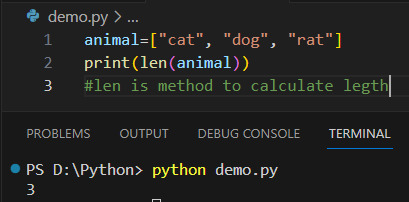
To add elements in array we use append method. For ex.: animal.append("fox")
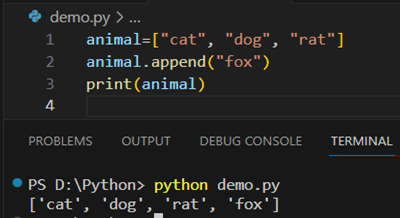
To delete elements in array we use pop method. it deleteindex wise.For Ex:animal.pop(1)
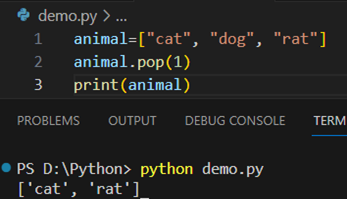
Removes all the elements from the list. Method:- clear()
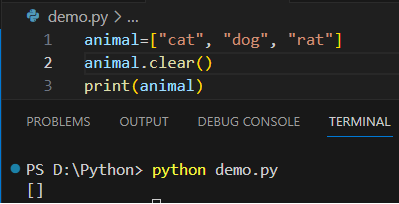
Returns the number of elements with the specific value. Method: count()
It will return index value of 4 that is 1.
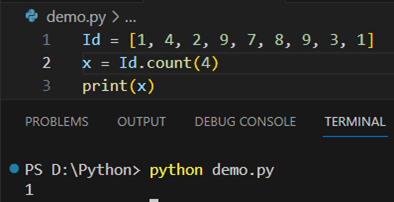
Adds an element at the specified position.Method:- insert()
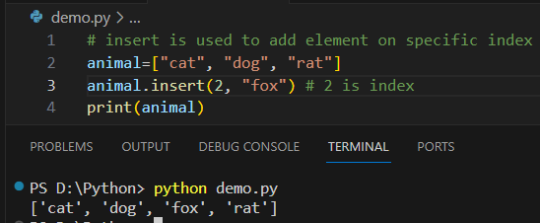
Removes the first item with the given value. Method: remove()

Reverses the order of the list. Method: reverse()
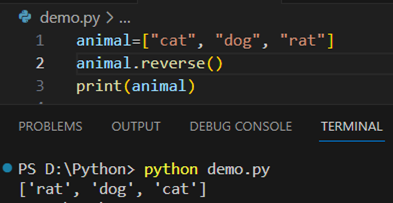
Sorts the list. Method: sort()
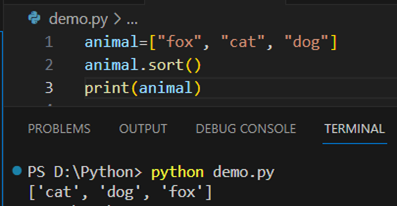
Class:
Class is a blueprint of an object.
It defines the structure and behavior of objects of that class.
The class keyword is used to define a class.
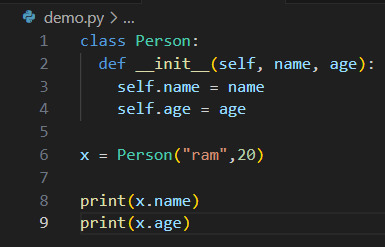
Object:
An object is an instance of a class and a collection of attributes and methods.
For ex.: x = Person("ram", 20)
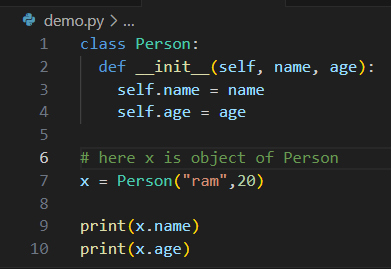
Inheritance:
Inheritance is a OOP concept that allows you to create a new class based on an existing class. The new class inherits attributes and methods from the existing class, which is referred to as the base or parent class. The newer class is called the derived or child class of the base class.
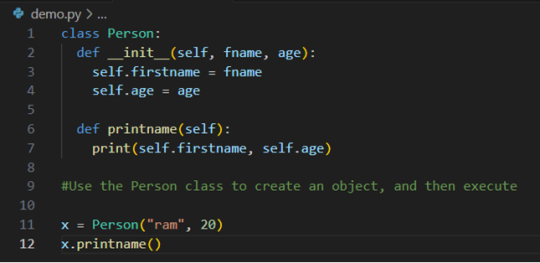
Polymorphism:
polymorphism means having many forms.
Method Overloading (Compile-Time Polymorphism):
having same name but different parameters.
Method Overriding (Run-Time Polymorphism):
having same name and same parameters.
Encapsulation:
simple lang. wrapping or hiding of data.
object has ability to hide data and behavior that is not necessary to use.
How to take User Input: For ex.
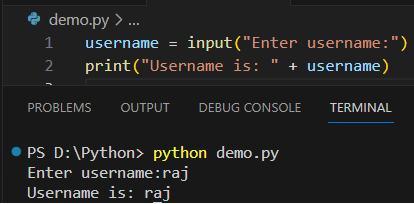
Closing Thought:
Python is a powerful and versatile programming language that has become an integral part of the technology. Everyone is using Python because of its simple syntax, and if you are a beginner, you should definitely go with python.
Credit – Priyanka Divekar
MetricsViews Pvt. Ltd.
MetricsViews specializes in building a solid DevOps strategy with cloud-native including AWS, GCP, Azure, Salesforce, and many more. We excel in microservice adoption, CI/CD, Orchestration, and Provisioning of Infrastructure - with Smart DevOps tools like Terraform, and CloudFormation on the cloud.
www.metricsviews.com.
0 notes
Text
My thoughts on TypeScript
When I was a child, I used to play construction with my Dad’s music cassette collection. Sometimes, I would mix up the cases and the cassettes inside for fun. When my Dad wanted to listen to the music he liked, he would be disturbed when a completely different song play. And he would be frustrated when he couldn’t find the real one.
I feel the same frustration whenever I try to access a property in a JavaScript object that is supposed to be available and It doesn’t exist.
JavaScript gives me “God” like powers where I can create objects in one form and change it into something different at my whim. Like turning a fox into a horse or turning blood to wine. But this power gave me problems just like how I gave my dad problems.
If I had the magic lamp, I would ask Genie Smith to find me a way to designate types to data & objects when I write code and not when I execute it. And he would’ve said “Dude you can use TypeScript. It has what you need”.
If you don’t know what TypeScript is, it is an open source programming language designed to provide type-safety to JS projects with its strict type system.
After learning typescript for a week, here are my thoughts on TypeScript.
1. A Super set of JavaScript
Typescript uses the same syntax as JavaScript with nifty additional features. And I love it.
Typescript is just like JS but has a strict syntactic structure with stringent datatype rules. I would say it as a meta-data to JavaScript as it gives additional information about types and object structures. It kind of reminds me of C++.
2. Type safety
The type system in TypeScript, the set of rules on how to assign data types or types for short to variables, objects and other elements of my code is very stringent. This ensures that I do not assign a Person object to an Animal object or add a string with a number. This is called type safety in computer programming. Though JavaScript has type safety, it’s more lenient in my opinion.
3. A bouncer
I feel that typescript is like a bouncer in a bar who push away people when they do not follow the party etiquettes. It’s because TS pushes me back whenever there is an inadvertent type-related error until I fix it. It might seem tedious, It’s helpful nonetheless. The TS compiler helped me prevent spending a lot of time to debug the error which is the case in JS.
4. Code Hinting
My favourite part of typescript is its ability to present hints while I code. When combined with powerful code editors like VS Code or Atom, the contextual code suggestions helped me reduce errors and increased my typing speed. TS can do this because it’s a statically typed language. It means information about types are available to the compiler before the compilation starts. This availability of information helps the editors compile my code on the go and provide contextual suggestions.
5. Red squiggly lines
Available separately the linter when enabled in the editor, can detect errors of syntactic, type and even contextual nature. It presents the errors by underlining the error part with red squiggly lines as I type. This makes error correction easier and faster
6. Planning Ahead
New nifty features in typescript like the call signatures, object structure definition and interfaces allow me to plan ahead on how I’ll be applying my design to the code. For example, the call signatures are similar to function declaration in C allow me to sketch out the number of parameters needed and the return type. And the Object structure definition allows me to design a skeleton for an object before I define it.
7. Versatility
What makes typescript versatile is its wide variety of configuration options. I can enable and disable different options to cater to my project’s needs.
One of the settings I used a lot is the target option. It flipped between commonJS module system and the es5 module system while learning.
8. Just too many options
TS has just too many configuration options for a beginner. The ignorance of the purpose of some of these options led me to trouble. I did not know I had to include a separate library to use the DOM functions. I was like “What do you mean getElementById is not defined?”
9. Type definition
What makes typescript great is, it allows programmers to define new types for their need. Making use of this feature the definitely.org community has created high-quality type definitions for popular JS frameworks like JQuery, node.js and Angular which allows the use of these frameworks in Typescript.
But, could not find enough information on how to use a JS plugin or framework if it is not supported by the definitely typed community.
10. Partial to node.js
Typescript has so many features that I found useful. But in terms of documentation, it is partial to node.js. I found lots of learning aids about TS for node.js. But I couldn’t find equivalent amounts of learning aids for front end programming.
Conclusion
As a beginner, all these strict rules felt time-consuming since it took less time to write the same in JS. Over time, I realized the usefulness of TS and started using its features as I learnt them. I’ve decided to use typescript in my next side project instead of JavaScript.
References
“Programming TypeScript, Making your Javascript applications to scale” by Borris Cherney. ISBN - 9781492037651
“Type system”, Wikipedia
“Data type”, Wikipedia
0 notes
Text
I made a Lemmy community for Mixels!
Here’s the link: https://lemmy.world/c/mixels?dataType=Post&page=1&sort=New
0 notes
Text
#incredibly fucked up#however#maybe I *would* consider brainfuck low level#conceptually it's about as close as anyone can get to programming on a turing machine#and for a hardware implementation it seems relatively easy to make a one-to-one conversion#<- largely inexperienced on all fronts of what she's saying so yknow take all that with a big grain of salt
Okay first before I respond, I'd like to share a much better-written essay on basically the same topic:
Reading that (↑) is what got me on this path of thinking in the first place. Also, I'd like to say explicitly that I'm not trying to be snobby or dismissive wrt to what you said, in case I didn't control my tone properly. Just trying to have a conversation, and I have a lot of thoughts! :)
Anyways, back to what you said: it's subjective, right? "High-level" and "low-level" are not rigidly defined terms--nor for that matter is "abstract".
We both, I'm sure, agree that BF is minimal--the formal specification is short, the list of instructions is short, the architectural requirements are short and easily mapped onto most machine languages. This is, of course, the point. Brainfuck was designed to be as easy to compile as possible--on the machines of then and today.
But I'd still argue that it's "abstract" -- in the sense that while it's easy to translate between BF and assembly/machine code, there's nothing in BF that enforces how this should be done.
That, in my mind, is the difference between a "low-level" and a "high-level" language: high level languages leave the implementation stack (that is, the entire chain from compiler/assembler to linker to OS to firmware to CPU to individual logic gates) room to interpret the action(s) you request; low level languages leave little to no room for such interpretation.
For example, take the '>' (increment data pointer) command. How might we translate this to a machine instruction? If our compilation target is an 8086-based computer, it would make sense to use register DX as our data pointer, and to increment it with INC DX (0x42). We don't have to, though--and this is the important part--we could just as easily use a different register for the data pointer, or even store it in main memory; we could increment DX with ADD DX, 1 (0x8201); we could increment DX by any other nonzero integer (and leave empty padding between cells, or simply use a different addressing mode for memory access); we could use an 8087 FPU instead of the onboard ALU to increment the data pointer; we could use a table in memory to fetch the new data pointer value (C equivalent: data_ptr = inc_data_ptr[data_ptr]); we could decrement the data pointer instead of incrementing, and vice versa for '<'; we could do any number of things!
Things are made further complicated by... other architectures. BF is portable, after all! Maybe our target architecture doesn't have registers. Now it's even less obvious where we should put the data pointer! Or maybe we're targeting a transport-triggered architecture. Which execution unit(s) should we use to implement our data pointer? Do we have a hardware data pointer? Do we have registers? These questions don't have clear-cut answers!
Other questions we'll have to answer range from "how big is a cell, anyway?" (is it a byte? a halfword? a word? a doubleword? a float?) to "what kind of datatype are we even doing math on here?" (is it a binary 2s-complement integer? 1s-complement? tagged int? float? BCD? is our machine even binary-based? [maybe we're in the Soviet Union in the late 70s and trying to implement BF on a Setun computer with a balanced ternary number system!]) to "how should we handle overflows?" (ignore? crash? something else?) to "what does our runtime look like?" (e.g. how do we return control to the OS? do we have to relinquish it willingly? do we have to initialize memory ourselves? do we have to initialize registers ourselves?) and beyond.
In other words, while there may often be an idiomatic translation, there is never a "correct" translation. BF only specifies is that there is a data pointer, and that '>' will make it point to the "next" cell.
Compare that, then, to a language I would consider "actually low-level": z80 assembly. If I give a z80 assembler the instruction INC HL, it will only ever emit the machine instruction "0x23", and the z80 processor, upon fetching and decoding this instruction, will only ever take the value in the HL register, increment it in the ALU, and put it back in the HL register.
Furthermore, the HL register is real--you can put a z80 CPU under a microscope and look at it, unlike x64 registers (which are merely abstractions for the actual details of the processor's register file--any given physical register could at any time be 'the DX register', for example) or the BF data pointer, which as stated above could be any number of things.
If I write a program in z80 assembly, I will know exactly how many clock cycles each step will take. If I write a program in BF, or x64, I will have no idea. It depends. It depends on so many things.
This, in my mind, is what makes BF (and x64 assembly) "high-level"--there's no control over what the execution stack is actually doing, only suggestions for the general shape. They're crude suggestions, don't get me wrong, but they're suggestions.
That's what drives me up the wall about x64. It used to be low-level, way back in the 80s, but over years and years of changes and refinements it just isn't anymore. Your PC's CPU isn't really an x64 processor--it's just pretending to be. It doesn't execute x64 machine code any more than it 'executes' JVM bytecode.
That's weird, right? I think it's weird. That's my real point.
Anyways, one final note on BF being easy to implement in hardware. This is true, but I don't think it's relevant. Any high level language could be run entirely in hardware given sufficient time, money, and mental illness* and likewise any low level language could be executed via an interpreter (or god forbid transpiler or decompiler).
What matters here is intent, though that's of course subjective. IMO, BF is intended to be portable, z80 assembly isn't. x64 assembly I would argue is also "portable", in a sense, between the many, many microarchitectures implementing it, all of whom are very different internally. (Look up the Via C3 and the Intel Itanium x86 emulation mode for a real trip)
In the end, none of this really matters. Like I said at the start, there's no objective list of "high-level" or "low-level" languages. Everything is nuanced, and mostly only worth discussing in relative terms. (e.g. "C is lower level than Java, Assembly is lower level than C, etc." instead of "Assembly is low level, Java is high level".)
At the end of the day, I'm just making an observation I thought was worth sharing. Hope I gave you something to think about! :)
*Look. Anyone willing to build a physical processor capable of natively running python is, like, definitionally abnormal. I say that with love. Don't build a python processor though.
x86_64 assembly is a kind of high-level language
191 notes
·
View notes
Video
youtube
STD::VARIANT IN C++17 | STORE DIFFERENT DATATYPES
0 notes